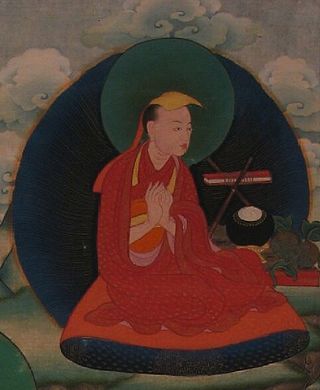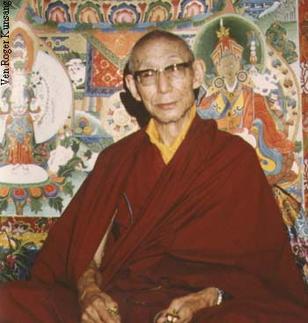
Dalai Lama is a title given by the Tibetan people to the foremost spiritual leader of the Gelug or "Yellow Hat" school of Tibetan Buddhism, the newest and most dominant of the four major schools of Tibetan Buddhism. The 14th and incumbent Dalai Lama is Tenzin Gyatso, who lives in exile as a refugee in India. The Dalai Lama is also considered to be the successor in a line of tulkus who are believed to be incarnations of Avalokiteśvara, the Bodhisattva of Compassion.

The Gelug is the newest of the four major schools of Tibetan Buddhism. It was founded by Je Tsongkhapa (1357–1419), a Tibetan philosopher, tantric yogi and lama and further expanded and developed by his disciples.

The Ganden Tripa, also spelled Gaden Tripa, is the title of the spiritual leader of the Gelug school of Tibetan Buddhism, the school that controlled central Tibet from the mid-17th century until the 1950s. The 103rd Ganden Tripa, Jetsun Lobsang Tenzin, died in office on 21 April 2017. Currently, Jangtse Choejey Kyabje Jetsun Lobsang Tenzin Palsangpo is the 104th Ganden Tripa.
The Dorje Shugden controversy is a controversy over Dorje Shugden, also known as Dolgyal, whom some consider to be one of several protectors of the Gelug school, the school of Tibetan Buddhism to which the Dalai Lamas belong. Dorje Shugden has become the symbolic focal point of a conflict over the "purity" of the Gelug school and the inclusion of non-Gelug teachings, especially Nyingma ones.

Gedun Gyatso, also Gendun Gyatso Palzangpo, was considered posthumously to have been the second Dalai Lama.

Ngawang Lobsang Gyatso was the 5th Dalai Lama and the first Dalai Lama to wield effective temporal and spiritual power over all Tibet. He is often referred to simply as the Great Fifth, being a key religious and temporal leader of Tibetan Buddhism and Tibet. Gyatso is credited with unifying all Tibet under the Ganden Phodrang after a Mongol military intervention which ended a protracted era of civil wars. As an independent head of state, he established relations with the Qing empire and other regional countries and also met early European explorers. Gyatso also wrote 24 volumes' worth of scholarly and religious works on a wide range of subjects.

Sera Monastery is one of the "great three" Gelug university monasteries of Tibet, located 1.25 miles (2.01 km) north of Lhasa and about 5 km (3.1 mi) north of the Jokhang. The other two are Ganden Monastery and Drepung Monastery. The origin of its name is attributed to a fact that during construction, the hill behind the monastery was covered with blooming wild roses.

Ganden Monastery or Ganden Namgyeling or Monastery of Gahlden is one of the "great three" Gelug university monasteries of Tibet. It is in Dagzê County, Lhasa. The other two are Sera Monastery and Drepung Monastery. Ganden Monastery was founded in 1409 by Je Tsongkhapa Lozang-dragpa, founder of the Gelug order. The monastery was destroyed after 1959, but has since been partially rebuilt. Another monastery with the same name and tradition was established in Southern India in 1966 by Tibetan exiles.

Drepung Monastery, located at the foot of Mount Gephel, is one of the "great three" Gelug university gompas (monasteries) of Tibet. The other two are Ganden Monastery and Sera Monastery.
This is a list of topics related to Tibet.

Kumbum Monastery, also called Ta'er Temple, is a Tibetan gompa in Lusar, Huangzhong County, Xining, Qinghai, China. It was founded in 1583 in a narrow valley close to the village of Lusar in the historical Tibetan region of Amdo. Its superior monastery is Drepung Monastery, immediately to the west of Lhasa. It is ranked in importance as second only to Lhasa.

Zong Rinpoche was a Gelug Lama and disciple of the third Trijang Rinpoche, junior tutor of the 14th Dalai Lama. He was famous as a sharp analyst and master of philosophical debate, as well as a Tantric practitioner. He was the Abbot of Ganden Shartse monastery.
The 1987–1989 Tibetan unrest was a series of protests and demonstrations that called for Tibetan independence. These protests took place between September 1987 and March 1989 in the Tibet Autonomous Region, in the Tibetan regions of Sichuan, and Qinghai, as well as the Tibetan prefectures in Yunnan and Gansu. Protests began shortly after the Dalai Lama, the religious and temporal leader of Tibet exiled in India since the 1959 Tibetan unrest, proposed a Five Point Peace Plan regarding the “status of Tibet” on September 21, 1987, which was subsequently rejected by the Chinese government. The Plan advocated for greater respect and autonomy of the Tibetan people, and claimed that “Tibet was a fully independent state when the People’s Liberation Army invaded the country in 1949-50.” China rejected the idea of Tibetans as an invaded people, stating that “Tibet is an inalienable part of Chinese territory” and has been for hundreds of years. The Tibetan sovereignty debate is longstanding, and the Tibetan assertion that they are a separate and unique people invaded by China has become a central argument for their independence.

Sönam Rapten, initially known as Gyalé Chödze and later on as Sönam Chöpel, was born in the Tholung valley in the Central Tibetan province of Ü. He started off as a monk-administrator of the Ganden Phodrang, the early Dalai Lamas' residence at Drepung Monastery, outside Lhasa, Tibet. From around or before the age of 20 he became the Treasurer and the "Chagdzo" of the Fourth (1589-1617) and, subsequently, the Fifth Dalai Lama (1617-1682). He presided as the most senior official of the Gelugpa school of Tibetan Buddhism for over 40 years.

Kyabje Yongzin Ling Rinpoche is a Tibetan tulku. The best-known incarnation is the sixth incarnation, Thupten Lungtok Namgyal Thinley, a Tibetan buddhist scholar and teacher.

The Third Trijang Rinpoche, Lobsang Yeshe Tenzin Gyatso (1901–1981) was a Gelugpa Lama and a direct disciple of Pabongkhapa Déchen Nyingpo. He succeeded Ling Rinpoche as the junior tutor of the 14th Dalai Lama when the Dalai Lama was nineteen years old. He was also a lama of many Gelug lamas who taught in the West including Zong Rinpoche, Geshe Rabten, Lama Yeshe, Kelsang Gyatso, and Lama Zopa Rinpoche. Trijang Rinpoche's oral teachings were recorded by Zimey Rinpoche in a book called the Yellow Book.
Tsenzhab Serkong Rinpoche was a master (tsenshab) of Tibetan Buddhism from the Gelug tradition. At the age of 34 in 1948 he was appointed from Ganden Jangtsey Monastery near Lhasa as one of seven teachers for the Dalai Lama.

Although there were many householder-yogis in Tibet, monasticism was the foundation of Buddhism in Tibet. There were over 6,000 monasteries in Tibet. However, nearly all of these were ransacked and destroyed by Red Guards during the Cultural Revolution. Most of the major monasteries have been at least partially re-established, while many others remain in ruins.
Norbu, with the later title of Depa and also known as Nangso Norbu, was a Tibetan government official born in the Central Tibetan province of Ü around the end of the 16th century. In 1644 he was appointed Governor of Shigatse, a post he held until 1659 when he succeeded his elder brother, Desi Sonam Rapten as de facto ruler of Tibet on behalf of Lobzang Gyatso, the Fifth Dalai Lama. After a brief reign he rebelled unsuccessfully against the latter and was banished. His last recorded activity was in 1660.
Kelden Gyatso (1607-1677) was a 17th-century Tibetan poet, scholar, and siddha. He was the first of the Rongwo Drubchen tulku lineage, and an important figure for Buddhism in Amdo, a region of north-eastern Tibet. The founder of a religious college and a seminary for tantric studies in Rebgong, throughout his life Kelden struggled between his desire to become a recluse hermit and his responsibility to these institutions. While he was ordained and taught in the Gelug school, he had a special affinity for Milarepa, the legendary Tibetan poet of the Kagyu school. The information that survives about Kelden comes from a biography by Jangchup Mila Ngawang Sönam (1636-1716), and from his poetry and songs, both written down and performed today by monks in Amdo.















